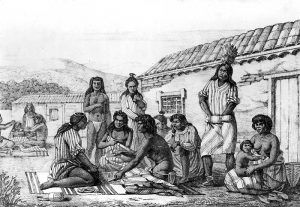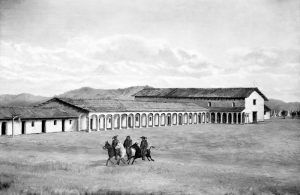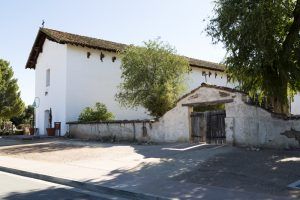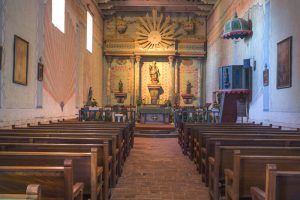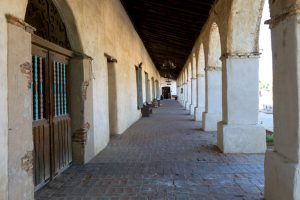Mission San Miguel Arcángel is a Spanish mission in San Miguel, California. It was the 16th of 21 Franciscan Catholic missions established in California during the 18th and early 19th centuries to expand the Spanish empire, settle the Pacific Coast region, and convert local American Indian tribes to Catholicism.
The Spanish selected the site along the Salinas River to ease travel between Mission San Antonio and Mission San Luis Obispo. Father Fermin Francisco de Lasuen founded Mission San Miguel Arcangel on July 25, 1797. That year, a temporary church and other buildings were built at the mission. The mission was named for the Archangel Saint Michael. The mission sat along the El Camino Real, the main overland route that connected the Spanish missions, presidios, and pueblos in Alta California. The road ran right next to a large Salinan Indian village.
The mission’s first priest, Father Buenaventura Sitjar, had a pre-existing relationship with the Salinan people, having ministered to them for 25 years at Mission San Antonio. Father Sitjar spoke the Salinan people’s language and baptized 15 Salinan children the day the mission was established. The founding of Mission San Miguel marked the beginning of a friendly relationship between the Salinan people and Spanish padres. Eventually, over 1,000 Salinan Indians would call the mission home.
In 1806, a fire destroyed the church, the other mission buildings, and all the stored farm products. At this time, there were more than 1,000 Salinans were living and working at the mission. Planning and preparation for a new and larger church began while rebuilding the other mission buildings. For the next ten years, Salinan neophytes made nearly 36,000 roof tiles and adobe blocks that they stored in preparation for constructing the new church. The foundation for the new church was laid in 1816, and by 1818, the new church, with its six feet thick adobe walls and a long colonnade with multiple arches of varying shapes and sizes, was finished. Esteban Munras, an artist from Monterey, designed and completed the interior murals with the help of the Salinan Indians by 1821. Today, these original murals have never been re-touched.
The mission’s grounds extended 18 miles to the north and south, 66 miles to the east, and 35 miles to the west. Such large land grants were necessary for the mission to grow crops, plant vineyards, raise cattle and sheep, and graze horses and mules for trade and to sustain their community. The success of the Mission was primarily due to Father Juan Martin, who served here from the beginning until 1824.
Life at Mission San Miguel changed after Mexico’s independence from Spain in 1821. Due to the financial strain of maintaining the missions, the Mexican government secularized the mission system and converted church property to private property. In 1834, Mission San Miguel was one of the last missions to be secularized. By this time, only about 30 Salinan Indians remained at the mission and no Spanish padres, at which time, a Mexican administrator took control of Mission San Miguel.
In 1846, business partners Petronillio Rios, a retired Mexican military man, and William Reed, an Englishman who had a wife from Monterey, purchased the mission buildings. The Reeds lived in the mission until a brutal attack from three Irish sailors, who had deserted their ship, left 11 family members and household staff dead in their house. After the vicious murders of the Reed family and their staff, and because of the mission’s location as a stopping point for gold miners traveling between Los Angeles and San Francisco, the mission’s buildings and grounds were converted for commercial use. The mission served as retail shops, a hotel, a saloon, and a dancehall at various times.
President Buchanan returned Mission San Miguel to the Catholic Church in 1859. By 1878, the newly assigned resident padre, Father Philip Farrely, ran the mission and established a new parish. Fifty years later, in 1928, the mission was officially returned to the Franciscans. Under the direction of the Franciscans once again, the mission became a novitiate training school and a center for retreats and meetings.
Today, the mission is still an active parish and a novitiate training facility. The church’s appearance today is much the same as when it was built. The inside of the church has never been repainted. The mission was placed on the National Register of Historic Places in 1971 and was named to a National Historic Landmark in 2006. Of California’s missions, it retains more than most of its layout and buildings, including a portion of its neophyte village.
Visitors today visit a museum and tour the grounds with a small donation.
More Information:
Mission San Miguel Arcàngel
775 Mission St
San Miguel, California 93451
805-467-3256
© Kathy Weiser-Alexander/Legends of America, updated November 2021.
Also See:
Missions & Presidios of the United States
Spanish Missions & Presidios Photo Gallery
Sources:


